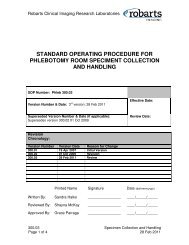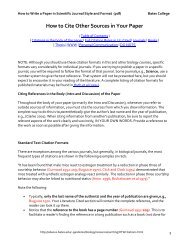How to write a thesis - Journal of Orthodontics
How to write a thesis - Journal of Orthodontics
How to write a thesis - Journal of Orthodontics
You also want an ePaper? Increase the reach of your titles
YUMPU automatically turns print PDFs into web optimized ePapers that Google loves.
<strong>Journal</strong> <strong>of</strong> <strong>Orthodontics</strong>, Vol. 31, 2004, 144–148FEATURESSECTION<strong>How</strong> <strong>to</strong> <strong>write</strong> a <strong>thesis</strong>S. J. CunninghamEastman Dental Institute for Oral Health Care Sciences, London, UKThe prospect <strong>of</strong> writing a <strong>thesis</strong> can be intimidating. <strong>How</strong>ever, there are certain formats that the <strong>write</strong>r should follow in order <strong>to</strong>make life much easier. This article covers a logical approach <strong>to</strong> presenting research findings. Also included are suggestions for alast minute checklist.Key words: Publishing, writing a <strong>thesis</strong>, writing a dissertationSo, you think the hard part is over now that your actualresearch is completed, but then you realize it is only justbeginning! The <strong>thesis</strong> has <strong>to</strong> be written up! <strong>How</strong>ever,there are many practical tips that can make writing-up asstress-free as possible.The ‘thinking’ part <strong>of</strong> writing is the hardest part <strong>of</strong> any<strong>thesis</strong>. 1 Most graduate schools have their own guide <strong>to</strong>writing a <strong>thesis</strong> or dissertation, and it is important thatthis is obtained (and read!) prior <strong>to</strong> commencing theresearch. Such guides <strong>of</strong>fer information on a wide spectrum<strong>of</strong> research-related issues, but more importantly,will also give other vital information, such as word limits,etc.The recommended format for theses is similar for mostinstitutions, with some local minor variations:• Title page• Abstract• Acknowledgements• Table <strong>of</strong> contents• Review <strong>of</strong> the literature — concluding with a summary• Statement <strong>of</strong> the problem, aims <strong>of</strong> the study, hypo<strong>thesis</strong>• Materials and methods (including statistical analysis)• Results• Discussion• Conclusions• Appendices• ReferencesTitle pageThe title page should include the following information:• Title <strong>of</strong> the <strong>thesis</strong> — usually centred on the page and inupper case letters.• Your full name and qualifications.• The name <strong>of</strong> the institution <strong>to</strong> which the <strong>thesis</strong> is beingsubmitted.• The degree for which the <strong>thesis</strong> is submitted and theyear <strong>of</strong> submission.AbstractThe abstract is placed immediately following the titlepage and is generally short (up <strong>to</strong> a side <strong>of</strong> A4 usually).The abstract should include a brief introduction andstatement <strong>of</strong> the problem, as well as a summary <strong>of</strong> themethodology, findings and conclusions. A structuredabstract may be used if preferred.AcknowledgementsIt is important <strong>to</strong> acknowledge your supervisors, statisticaladvisers and others who have helped (e.g. colleagueswho have <strong>of</strong>fered support or provided data). In addition,any funding bodies should be mentioned. It is alsocus<strong>to</strong>mary <strong>to</strong> refer <strong>to</strong> those who have had <strong>to</strong> ‘put up’ withyou during the process <strong>of</strong> writing the <strong>thesis</strong> — usuallyfamily and friends!!Table <strong>of</strong> contentsConventionally, there should be a table <strong>of</strong> contents,followed by a list <strong>of</strong> tables and a list <strong>of</strong> figures. The table<strong>of</strong> contents includes all the major divisions <strong>of</strong> the <strong>thesis</strong>,including subsections. The relationship between majordivisions and minor subdivisions should be shown byan appropriate use <strong>of</strong> capitals and indentations. 2 Thepreliminary pages (Abstract, Acknowledgements andAddress for correspondence: S. J. Cunningham, Department <strong>of</strong> <strong>Orthodontics</strong>,Eastman Dental Institute for Oral Health Care Sciences, University CollegeLondon, 256 Gray’s Inn Road, London WC1X 8LD, UK.Email: S.Cunningham@eastman.ucl.ac.uk© 2004 British Orthodontic Society DOI 10.1179/146531204225020445
JO June 2004 Features Section<strong>How</strong> <strong>to</strong> <strong>write</strong> a <strong>thesis</strong> 145Contents) are numbered using roman numerals (i, ii, ii. . . .) and the remainder <strong>of</strong> the <strong>thesis</strong> is numbered usingArabic numerals (1, 2, 3 . . .). The title page is notnumbered. It is sensible <strong>to</strong> start writing a table <strong>of</strong> contentsas you <strong>write</strong> the <strong>thesis</strong>; however, the page numberscan only be added when you have completed the finaldraft. At this stage, always cross-check the page numbersbetween the table <strong>of</strong> contents and the main body <strong>of</strong> thetext — and ask someone <strong>to</strong> double check them for you.The list <strong>of</strong> tables or figures follow the same format, witheach table/figure number in Arabic numerals, the exacttitle as it appears in the main text and also the pagenumber.Review <strong>of</strong> the literatureBeginning this section can be a daunting task, particularlyif your research area is extensive. This should be one<strong>of</strong> the first things you do, and if the majority <strong>of</strong> this workis undertaken relatively early in the project, it makes laterstages very much easier. The review <strong>of</strong> the literatureshould be as comprehensive as possible in the space available.Include only material that gives an appropriatebackground <strong>to</strong> your study and avoid the temptation <strong>to</strong>include everything you have ever read on the subject!Obviously, this review must be constantly updated <strong>to</strong>ensure you do not miss important additions <strong>to</strong> the literatureand a final search should always be undertakenimmediately prior <strong>to</strong> submission, and also just before theviva in case an important work has been published in thetime between submission and examination.Make sure you acknowledge which paper something iscited in if you did not actually read it yourself. An examinermay find it hard <strong>to</strong> believe that you managed <strong>to</strong> get acopy <strong>of</strong> a 1932 Russian orthodontic journal, let alonemanaged <strong>to</strong> translate it yourself!Great care is required in the way the references arequoted in the text, especially with respect <strong>to</strong> punctuation,etc. If several papers are quoted at the same point, theyshould always be in chronological order.Statement <strong>of</strong> the problem, aims andhypo<strong>thesis</strong>The literature review is followed by a statement <strong>of</strong> theproblem, then the aims <strong>of</strong> the study and the hypo<strong>thesis</strong>.Traditionally, null hypotheses were used because theyhave their basis in inferential statistics. <strong>How</strong>ever, it isnow much more acceptable <strong>to</strong> pose a hypo<strong>thesis</strong> in itspositive form. When writing up the results and discussion,it is important <strong>to</strong> make sure that this hypo<strong>thesis</strong> isactually answered.Materials and methodFull details should be included in the materials andmethods so that the reader could repeat the study if theywished. For this reason, details should also be provided<strong>of</strong> any equipment and materials used. These can beplaced in a separate appendix if necessary (see later). It isalso useful <strong>to</strong> start writing this section as you undertakeyour research, not only will everything be very fresh inyour mind at this stage, but it will also mean you have less<strong>to</strong> do at a later stage.This section allows readers <strong>to</strong> understand the objectives<strong>of</strong> the study and <strong>to</strong> judge whether the methods used wereappropriate. The methods may actually be modifiedduring the process <strong>of</strong> the study, in which case, the finalform <strong>of</strong> the method is discussed (unless advised otherwiseby your supervisor). The most serious error in this sectionis <strong>to</strong> omit important information required by the reader<strong>to</strong> see the logic <strong>of</strong> the study and <strong>to</strong> judge the adequacy <strong>of</strong>the method. 1Everything <strong>to</strong> do with the validity <strong>of</strong> the method shouldbe included in this section, including design, instrumentation,analysis, etc. This section should also containevidence <strong>of</strong> the reliability <strong>of</strong> the method.There is a great deal <strong>of</strong> individual variation in thesubheadings used in this section, <strong>of</strong>ten depending on thetype <strong>of</strong> research undertaken. <strong>How</strong>ever, possible examplesinclude:• subjects;• design;• materials, apparatus and procedures;• statistical analysis;• validity and reliability <strong>of</strong> method.SubjectsThere are two particularly important aspects <strong>to</strong> beconsidered here, both <strong>of</strong> which determine the generality<strong>of</strong> the findings: 1• The number <strong>of</strong> subjects at each stage (this establishesthe statistical power).• Freedom from bias in the way the subjects areobtained/recruited. In clinical studies, we frequentlyfail <strong>to</strong> achieve random selection for obvious reasonsand it should be acknowledged if this is so. At this stageit is also important <strong>to</strong> consider that, particularly whencomparing two groups, the groups may not be balanced.If this is the case, you will need <strong>to</strong> take this in<strong>to</strong>account and select an appropriate statistical analysis.Full details <strong>of</strong> subjects should be included: number, agegroup, gender, where they were recruited from, inclusionand exclusion criteria, how many subjects were asked <strong>to</strong>take part and how many agreed, drop-out rate, etc. It is
146 S. J. Cunningham Features SectionJO June 2004also important <strong>to</strong> discuss power and sample size at thispoint and explain how you arrived at the estimatednumber <strong>of</strong> subjects/samples, etc.DesignThis section describes exactly what type <strong>of</strong> study wasundertaken. For example, a prospective randomizedcontrolled trial comparing the effect <strong>of</strong> early treatmentwith a functional appliance.Materials, apparatus and proceduresThis section includes all procedural elements that willallow the reader <strong>to</strong> understand what happened. It may beworth using diagrams or pho<strong>to</strong>graphs if complex apparatuswas used. Likewise, a flow chart can make a complexprocedure seem much more straightforward. Someaspects may be included in an Appendix, e.g. informationsheets given <strong>to</strong> patients, details <strong>of</strong> the manufacturers <strong>of</strong>apparatus or chemical reagents used.Validity and reliabilityThe reliability and validity <strong>of</strong> any method should beaddressed at this stage. At this point it is also appropriate<strong>to</strong> include any threats <strong>to</strong> the validity <strong>of</strong> the method (e.g.loss <strong>of</strong> subjects in a longitudinal study).Limitations <strong>of</strong> the method should be discussed fullyin the Discussion section. It is better <strong>to</strong> be honestand acknowledge any issues, rather than allowing theexaminer <strong>to</strong> point them out <strong>to</strong> you. There are problemsassociated with all studies and examiners do realize that.Statistical analysisIt is a failing <strong>of</strong> many research studies that statisticaladvice was obtained <strong>to</strong>o late <strong>to</strong> be <strong>of</strong> any real use and thewriting-up stage is certainly not the time <strong>to</strong> consult yourstatistician for the first time! They should have formedpart <strong>of</strong> the research team from the outset, and this is thetime for them <strong>to</strong> provide support as you undertakethe necessary analyses and <strong>to</strong> <strong>of</strong>fer advice regardinginterpretation <strong>of</strong> data.The statistical tests should be discussed fully, alongwith any criteria that were fulfilled in order <strong>to</strong> use thesetests (e.g. Normality <strong>of</strong> data).ResultsThe results should be presented in a clear, concise mannerand avoid the temptation <strong>to</strong> present in more than oneformat (e.g. in both tables and graphs). It is <strong>of</strong>ten helpful<strong>to</strong> precede each sub-section <strong>of</strong> results with a summaryparagraph, but avoid duplication. Tables and figuresshould be as simple as possible and the use <strong>of</strong> verycomplicated graphics or obscure colour combinationsavoided — the examiner will not thank you! The table orfigure should not repeat information covered in the maintext, it should augment it. Every table and figure shouldhave a title that is a concise explanation <strong>of</strong> what is beingpresented. If abbreviations are used, it is important thatthey are explained fully.Tables where p-values are quoted should give the actualp-value, rather than p


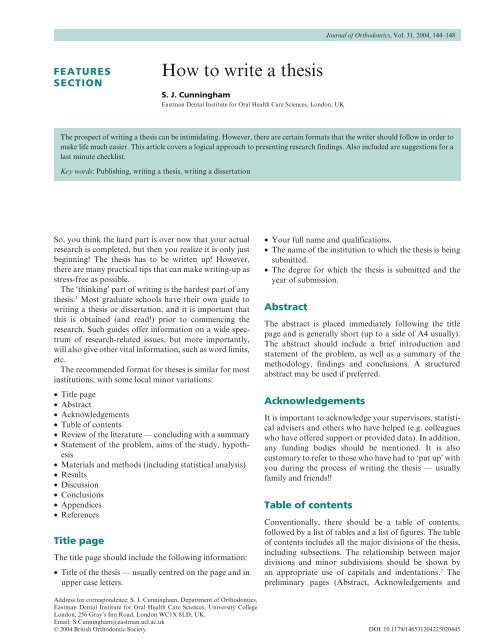

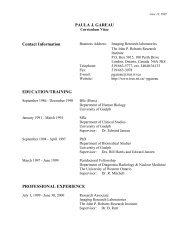

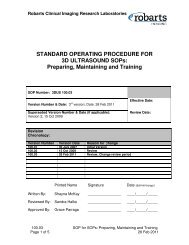
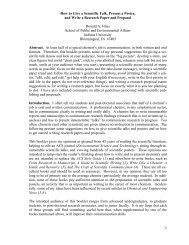
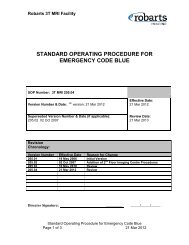

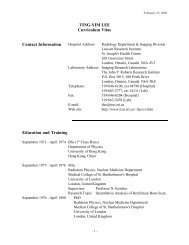

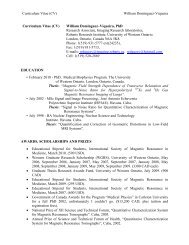

![how to read a scientific [journal] article - Robarts Imaging](https://img.yumpu.com/44345644/1/190x245/how-to-read-a-scientific-journal-article-robarts-imaging.jpg?quality=85)
